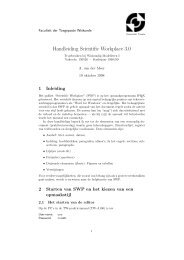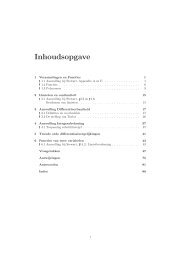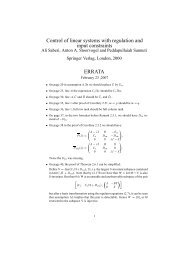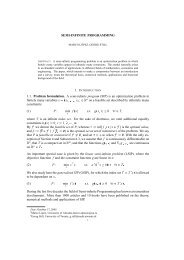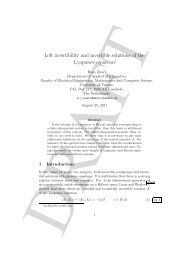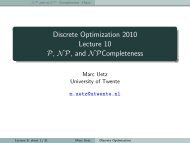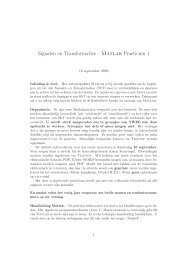Lecture Notes Discrete Optimization - Applied Mathematics
Lecture Notes Discrete Optimization - Applied Mathematics
Lecture Notes Discrete Optimization - Applied Mathematics
You also want an ePaper? Increase the reach of your titles
YUMPU automatically turns print PDFs into web optimized ePapers that Google loves.
largest lower bound onOPT LP ) corresponds to the so-called dual program of (2).<br />
maximize<br />
subject to<br />
m<br />
∑<br />
i=1<br />
m<br />
∑<br />
i=1<br />
b i y i<br />
a i j y i ≤ c j ∀ j ∈{1,...,n}<br />
y i ≥ 0 ∀i∈{1,...,m}<br />
(4)<br />
We use OPT DP to refer to the objective function value of an optimal solution to the dual<br />
linear program (4).<br />
There is a strong relation between the primal LP (2) and its corresponding dual LP (4).<br />
Note that (3) shows that the objective function value of an arbitrary feasible dual solution<br />
(y i ) is less than or equal to the objective function value of an arbitrary feasible primal<br />
solution (x j ). In particular, this relation also holds for the optimal solutions and thus<br />
OPT DP ≤ OPT LP . This is sometimes called weak duality. From linear programming<br />
theory, we know that even a stronger relation holds:<br />
Theorem 1.1 (strong duality). Let x=(x j ) and y=(y i ) be feasible solutions to the LPs<br />
(2) and (4), respectively. Then x and y are optimal solutions if and only if<br />
n<br />
∑<br />
j=1<br />
c j x j =<br />
m<br />
∑<br />
i=1<br />
b i y i .<br />
An alternative characterization is given by the complementary slackness conditions:<br />
Theorem 1.2. Let x = (x j ) and y = (y i ) be feasible solutions to the LPs (2) and (4),<br />
respectively. Then x and y are optimal solutions if and only if the following conditions<br />
hold:<br />
1. Primal complementary slackness conditions: for every j∈{1,...,n}, either x j = 0<br />
or the corresponding dual constraint is tight, i.e.,<br />
∀ j ∈{1,...,n} : x j > 0 ⇒<br />
m<br />
∑<br />
i=1<br />
a i j y i = c j .<br />
2. Dual complementary slackness conditions: for every i∈{1,...,m}, either y i = 0<br />
or the corresponding primal constraint is tight, i.e.,<br />
∀i∈{1,...,m} : y i > 0 ⇒<br />
n<br />
∑<br />
j=1<br />
a i j x j = b i .<br />
6



